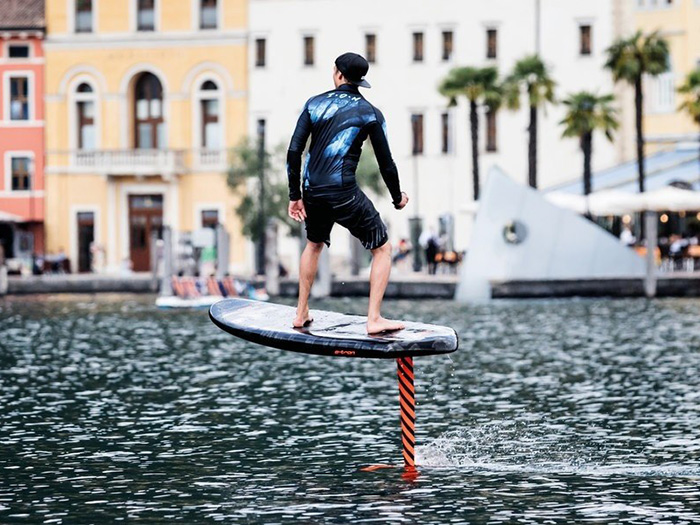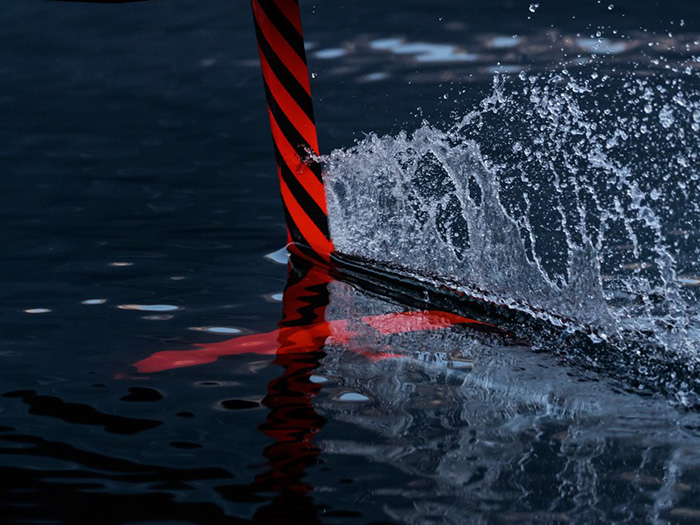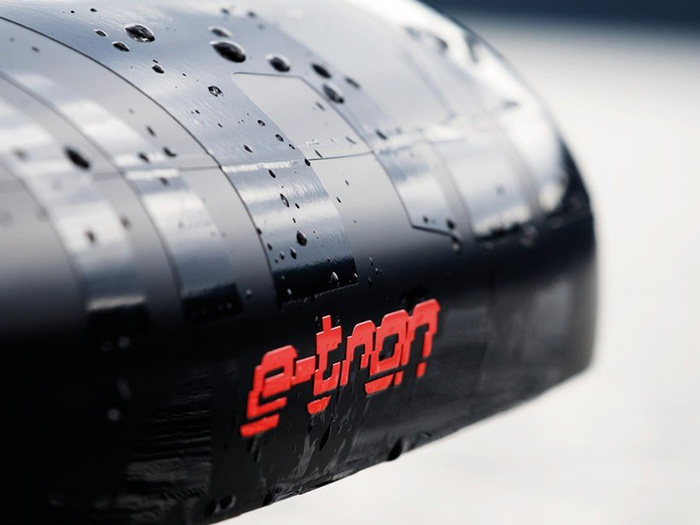Flying on water with the Audi surfboard e-foil
The Audi engineer Franz Hofmann has developed a foil surfboard powered by an electric propulsion jet motor.
All at once, everything is blissfully calm, then the water ‘s surface ripples and creates whirlpools. This is the only sound generated by a surfboard which goes fast, about a metre above the surface. It looks like a flying carpet, if it were not for a carbon foil connecting the electric motor to the board, creating a “hydrofoil surfboard”. A project that was developed by Franz Hofmann, an Audi engineer with a kitesurfing hobby, who personally tests the board by accelerating through a remote control - similar to the type used on electrically powered skateboards - using his right index finger.
The revolution of foil
In recent years, all water-sport disciplines have succumbed to foiling fever. A revolution which has affected also the watercrafts of the America’s Cup, the most prestigious sailing competition, to then rapidly spread among various disciplines, such as windsurf and kitesurf. A foil is an appendix - usually in the shape of a reverse T - which is connected to the lower part of the board, and can produce a vertical thrust and make the watercraft lift out of the water. In this way, the contact surface touching the water is drastically reduced and so is the hydrodynamic resistance, resulting in a speed acceleration even in low-wind conditions.
Air and water

At Audi, Hofmann is responsible for developing hydrogen tanks, meaning that he is very skilled at working with carbon fibre, the same material used to build foils. The project has been developed together with Christian Rössler, world champion and record holder in model aircraft disciplines, and above all aerospace engineer. Rössler works at the Institute of Aircraft Design at the Technical University of Munich (TUM), where he is responsible for the design of unmanned aerial systems, and Hofmann got him involved as an expert in flow technology, since a foil - in short – is like an airplane flying underwater. In 2015 they have completed the first prototype at home, then they tested it in all the world’s waters: Cuba, Vietnam, Sri Lanka and the Germany’s Baltic coast.
Jet propulsion

The real source of inspiration for Hofmann, though, is the engineering work he faces every day. “The drivetrain of the future? Electric motors will soon be taking to the water across the board. And there is no better time to combine these two elements”. So he presented the prototype to his colleagues at Audi, who liked the idea and came to the conclusion that it would be fascinating to turn the project into an Audi product. They added a battery on the board - initially in a watertight case strapped to it, and then integrated in a compartment set into the board itself. And many other components are developed with the best technologies, because of the direct involvement of Ingolstadt: from plug-in connectors to the jet-propulsion system’s housing, created with 3D printing based on the requested requirements. “Wedidn’t invent the e-foil, there are hundreds of projects like it around the world. What we are doing, however, is combining our high-performance foil with jet propulsion, creating a very efficient and safe combination” Hofmann explains. The jet-propulsion system used on the Audi e-foil comprises an impeller, a small enclosed propeller that accelerates the water, and a stator placed immediately downstream that eliminates the swirl from the flow and ensures that the accelerated water flows in a straight line.
Entertainment for everyone
During 2019 a limited production of the e-foil surfboard will be built to give potential customers the chance to test it. The price will be in line with the other products currently on the market; usage is pretty simple, at least according to Hofmann: after a couple of days’ practice, virtually any amateur surfer will be flying over the water on it - easier than standing on a balance board at the gym.
e-tron e-foil

At the base of the 100-centimeter-long foil mast sits the foil and tail assembly, whose upthrust lifts the board out of the water. All three components are carbon fibre, while the jet propulsion system is made of aluminium and is cooled down by the water temperature. The battery power is between 3 and 5 kW, based on the weight of the surfer, and a battery charging time of one hour offers a range in excess of 30 km. The e-foil lifts out of the water at around 17 kilometres per hour and can reach speeds of up to 45 kilometres per hour.
Source: AUDI AG
